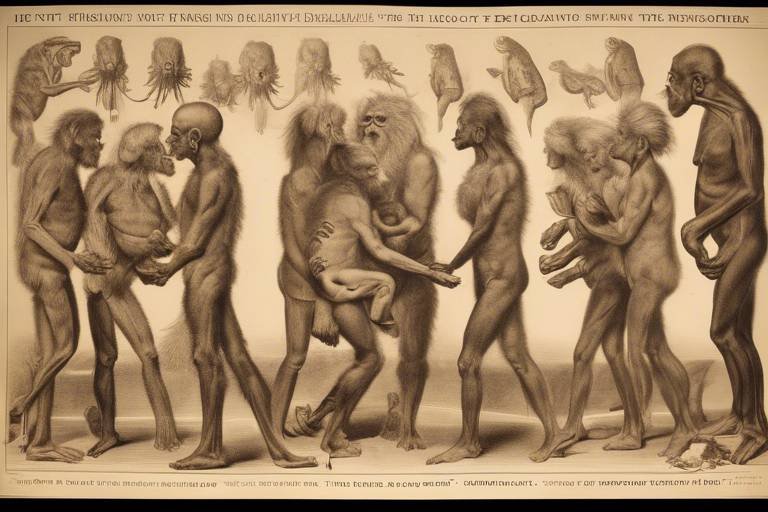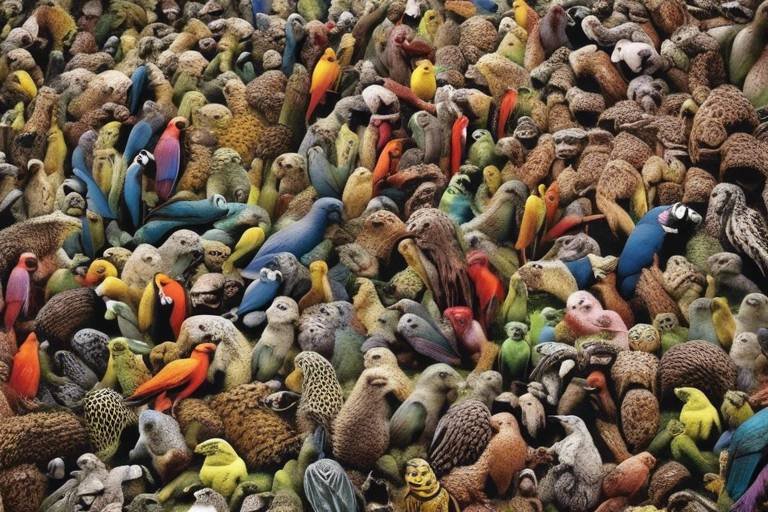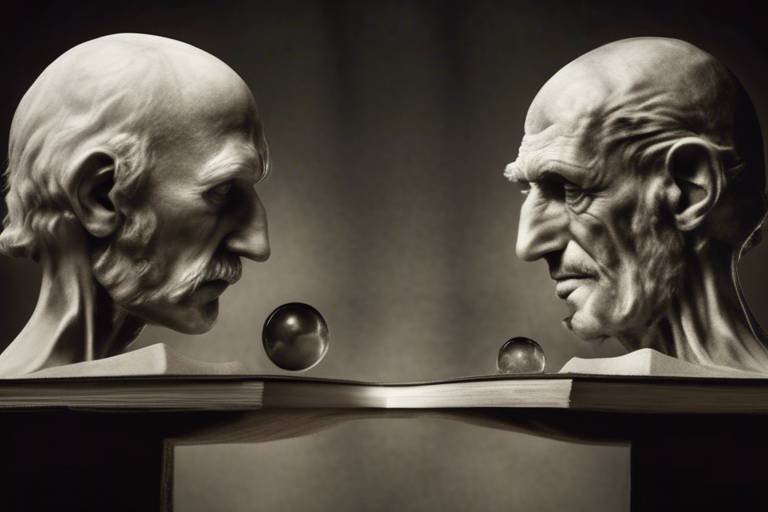Chaos Theory - A Fusion of Mathematics, Science, and Philosophy
Chaos theory is not just a niche area of study; it's a fascinating lens through which we can view the world. Imagine a world where tiny changes can lead to monumental shifts—like how a butterfly flapping its wings in one part of the world can set off a tornado in another. This theory intertwines mathematics, science, and philosophy, creating a rich tapestry that challenges our understanding of order, predictability, and the very nature of reality. As we delve into chaos theory, we uncover its intricate connections to various fields, revealing how it reshapes our perceptions of complex systems.
At its core, chaos theory examines the unpredictable nature of complex systems. It dares us to ask: what happens when we slightly alter initial conditions? The results can be astonishingly different, demonstrating that even the smallest inputs can lead to vastly divergent outcomes. This unpredictability is not merely a mathematical curiosity; it resonates throughout nature, economics, and even our daily lives. Think of it as a cosmic game of dominoes—once you tip one, the entire structure can collapse or transform in unexpected ways.
As we navigate through this article, we will explore the historical evolution of chaos theory, spotlighting the key figures who have shaped its development. We'll also dive into its applications across various scientific fields, and ponder its philosophical implications. The journey through chaos theory is not just about understanding mathematics or science; it's about embracing the chaotic beauty of existence itself.
Chaos theory is a multidisciplinary field that reveals how complex systems behave in seemingly random ways. It suggests that systems governed by deterministic laws can still produce unpredictable outcomes. This paradox is what makes chaos theory so intriguing. For example, in meteorology, predicting the weather is notoriously difficult because of the chaotic nature of atmospheric systems. A small change in temperature or humidity can lead to entirely different weather patterns, showcasing the inherent unpredictability of our environment.
In essence, chaos theory teaches us that while we may strive for order and predictability, the universe often operates on a different wavelength. This realization can be both humbling and empowering. It invites us to embrace uncertainty and to recognize that chaos is not merely disorder, but a complex form of order that we are yet to fully understand.
The journey of chaos theory is as intricate as the systems it seeks to explain. Its roots can be traced back to early mathematical concepts, but it truly began to flourish in the 20th century. Key breakthroughs and influential figures have played pivotal roles in shaping the landscape of chaos theory. Mathematicians and scientists have contributed unique insights that have propelled our understanding forward.
Two of the most prominent figures in chaos theory are Edward Lorenz and Benoit Mandelbrot. Their work has not only defined chaos theory but has also provided us with tools to visualize and understand chaotic systems.
Edward Lorenz's discovery of the butterfly effect is perhaps one of the most famous concepts in chaos theory. He found that minor variations in initial conditions could lead to drastically different weather outcomes. This idea highlights the interconnectedness of chaotic systems and serves as a reminder that our world is far more complex than it appears. Just as a butterfly's wings can create a ripple effect across the globe, our actions can have unforeseen consequences.
Benoit Mandelbrot introduced the concept of fractals, which are geometric shapes that exhibit self-similarity across different scales. Fractals provide a stunning visual representation of chaos in nature and mathematics. They remind us that chaos is not random; rather, it is a structured form of complexity that can be observed in everything from coastlines to clouds. Mandelbrot's work has opened our eyes to the beauty and intricacies of chaotic systems.
Chaos theory has practical applications that extend across various scientific disciplines. In meteorology, it enables scientists to model and predict weather patterns more accurately. In biology, chaos theory helps researchers understand population dynamics and the spread of diseases. Engineers utilize chaos theory to design more efficient systems, from traffic flow to electrical circuits. The versatility of chaos theory underscores its significance in our quest to comprehend complex phenomena.
The philosophical implications of chaos theory are profound. It challenges traditional notions of determinism and invites us to question the nature of reality itself. Are we merely products of a deterministic universe, or do we possess free will in a world governed by chaos? These questions have sparked rich philosophical debates, inviting thinkers from various backgrounds to ponder the implications of chaos on our understanding of existence.
Chaos theory raises intriguing questions about the balance between determinism and free will. If the universe operates on deterministic laws, how do we account for the randomness that chaos theory reveals? This tension between order and chaos invites us to explore the depths of our own decision-making processes and the extent to which we shape our destinies.
In exploring the balance between chaos and order, we find that complex systems can exhibit emergent behaviors that appear orderly despite their chaotic underpinnings. This phenomenon is akin to watching a flock of birds move in perfect synchronization, even though each bird is following its own path. Understanding this balance can help us appreciate the beauty of complexity in our lives and the world around us.
The future of chaos theory holds immense promise for new discoveries and applications. As we delve deeper into fields like artificial intelligence and complex adaptive systems, the insights gleaned from chaos theory will undoubtedly drive further interdisciplinary research. The fusion of mathematics, science, and philosophy will continue to illuminate the intricacies of our universe, inviting us to embrace the chaos that surrounds us.
- What is chaos theory? Chaos theory studies how small changes in initial conditions can lead to vastly different outcomes in complex systems.
- Who are the key figures in chaos theory? Edward Lorenz and Benoit Mandelbrot are two prominent contributors who have significantly shaped the field.
- How is chaos theory applied in science? It has applications in meteorology, biology, and engineering, helping to model and predict complex phenomena.
- What are the philosophical implications of chaos theory? It challenges traditional notions of determinism and prompts discussions about free will and the nature of reality.

[Understanding Chaos Theory]
Chaos theory is a fascinating branch of mathematics and science that dives into the unpredictable nature of complex systems. Imagine a tiny butterfly flapping its wings in Brazil, which ultimately leads to a tornado in Texas. This vivid imagery encapsulates the essence of chaos theory: small changes in initial conditions can yield dramatically different outcomes. It’s like a game of dominoes, where the slightest nudge can send the entire structure tumbling down in unexpected ways. At its core, chaos theory challenges our traditional understanding of predictability and control, suggesting that even in systems governed by deterministic laws, unpredictability can reign supreme.
To grasp the concept of chaos theory, it's essential to understand a few key principles. First, chaos is not synonymous with randomness. Rather, chaotic systems are highly sensitive to initial conditions, meaning that even a minuscule variation can lead to a vastly different result. This sensitivity is often referred to as the "butterfly effect," named after the aforementioned butterfly that can cause a chain reaction leading to significant events elsewhere. In chaotic systems, predictability diminishes over time, making long-term forecasting nearly impossible.
Another vital aspect of chaos theory is its application across various fields. Whether it’s the unpredictable patterns of weather, the fluctuations in stock markets, or the complex behaviors of ecosystems, chaos theory provides a framework to analyze and understand these phenomena. For instance, in meteorology, scientists utilize chaos theory to improve weather predictions by acknowledging that slight changes in atmospheric conditions can lead to different weather outcomes. This realization has transformed how we approach forecasting, emphasizing the importance of continuous data collection and model refinement.
Moreover, chaos theory reveals that chaos can coexist with order. This paradoxical relationship is evident in nature, where complex systems often exhibit patterns or structures despite their underlying chaotic behavior. For example, the formation of clouds or the branching of trees can be described by mathematical models that reveal their intricate beauty, yet these structures arise from chaotic processes. In essence, chaos theory helps us appreciate the delicate balance between disorder and order in our universe.
In summary, chaos theory offers a profound insight into the complexity of the world around us. By understanding that small changes can lead to significant consequences, we can better navigate the unpredictable nature of various systems. This understanding not only enhances our scientific knowledge but also encourages a philosophical exploration of determinism and free will, challenging us to reconsider our perceptions of control and predictability in life.

[Historical Background]
The journey of chaos theory is akin to a winding river, flowing through the realms of mathematics, science, and philosophy. Its roots can be traced back to the early explorations of dynamical systems in the 19th century, but it wasn't until the mid-20th century that chaos theory began to take shape as a distinct field of study. The evolution of this theory has been marked by a series of groundbreaking discoveries that have reshaped our understanding of complex systems.
One of the pivotal moments in the history of chaos theory occurred in the 1960s when meteorologist Edward Lorenz stumbled upon the concept that would later be known as the Butterfly Effect. While running weather simulations on a computer, Lorenz discovered that tiny changes in the initial conditions of his model could lead to vastly different weather outcomes. This revelation was not just a scientific breakthrough; it was a philosophical awakening that suggested the universe is far more unpredictable than previously thought.
Simultaneously, another key figure, Benoit Mandelbrot, was making waves in the world of mathematics. His work on fractals introduced a new way of visualizing chaos. Fractals are intricate geometric shapes that display self-similarity at different scales, illustrating the idea that chaos can manifest in beautiful and complex patterns. Mandelbrot's insights provided a visual language for chaos theory, allowing scientists and mathematicians to better understand the chaotic phenomena present in nature.
The 1980s and 1990s saw chaos theory gain traction across various scientific disciplines. Researchers began to apply the principles of chaos to fields such as biology, economics, and engineering. The realization that chaotic systems could be modeled and studied opened up new avenues for research, leading to advancements in predicting phenomena ranging from population dynamics to stock market fluctuations.
Today, chaos theory is not just a niche area of study; it has become a foundational concept in understanding complex systems. Its historical development reflects a rich tapestry woven from the contributions of numerous scientists and mathematicians, each adding their unique thread to the narrative. The interplay between chaos and order continues to captivate researchers, prompting them to explore the implications of chaos theory in our everyday lives.
As we look back on the historical milestones of chaos theory, it is clear that its evolution has been driven by curiosity and the desire to unravel the mysteries of the universe. From Lorenz's weather models to Mandelbrot's fractals, the journey of chaos theory is a testament to human ingenuity and the relentless quest for knowledge.
- What is chaos theory? Chaos theory is a branch of mathematics and science that studies complex systems whose behavior is highly sensitive to initial conditions.
- Who are the key figures in chaos theory? Notable contributors include Edward Lorenz, known for the Butterfly Effect, and Benoit Mandelbrot, who introduced fractals.
- How is chaos theory applied in real life? It is used in various fields, including meteorology, biology, engineering, and economics, to model unpredictable systems.
- What are fractals? Fractals are geometric shapes that exhibit self-similarity at different scales, providing a visual representation of chaos.

[Key Contributors]
Chaos theory, a fascinating intersection of mathematics, science, and philosophy, owes much of its development to a handful of brilliant minds. Among these, Edward Lorenz and Benoit Mandelbrot stand out as pivotal figures whose insights have profoundly shaped our understanding of chaos. Lorenz, a meteorologist, stumbled upon the concept of the Butterfly Effect while working on weather prediction models. His groundbreaking work demonstrated that small changes in initial conditions could lead to drastically different weather outcomes. This idea not only revolutionized meteorology but also sparked a broader interest in how chaotic systems operate across various fields.
On the other hand, Benoit Mandelbrot introduced us to the mesmerizing world of fractals. His exploration of self-similar geometric shapes revealed a hidden order within chaos, showcasing how complex patterns can emerge from simple mathematical rules. Mandelbrot’s work provided a visual representation of chaos that resonated with both scientists and artists alike, illustrating that chaos is not merely disorder but rather a complex interplay of patterns waiting to be discovered.
These two thinkers not only contributed unique methodologies but also inspired a generation of researchers to delve deeper into the implications of chaos theory in their respective fields. The fusion of their ideas has led to practical applications in science, art, and even philosophy, demonstrating that chaos is an integral part of the universe's fabric.
To better understand the contributions of these key figures, let’s take a look at a brief comparison:
| Contributor | Key Contribution | Field |
|---|---|---|
| Edward Lorenz | Discovered the Butterfly Effect | Meteorology |
| Benoit Mandelbrot | Developed the concept of Fractals | Mathematics/Art |
In summary, the contributions of Lorenz and Mandelbrot to chaos theory have not only expanded our understanding of complex systems but also opened up new avenues for research and exploration. Their legacies continue to influence various disciplines, encouraging us to embrace the beauty and unpredictability of chaos in our ever-evolving world.

[Edward Lorenz's Butterfly Effect]
The concept of the Butterfly Effect is one of the most captivating ideas to emerge from chaos theory, and it was popularized by the pioneering work of mathematician and meteorologist Edward Lorenz. Imagine a butterfly flapping its wings in Brazil, and as a result, a tornado forms in Texas weeks later. This metaphor beautifully encapsulates how minute changes in initial conditions can lead to vastly different outcomes in complex systems. Lorenz stumbled upon this idea while working on weather prediction models, and it fundamentally changed how we view the interplay between chaos and predictability in nature.
To understand the Butterfly Effect, it's essential to grasp the notion of sensitivity to initial conditions. In simple terms, this means that even the tiniest alteration in the starting point of a system can lead to drastically different results. For instance, if a weather model is initialized with slightly different temperature or pressure readings, the forecasts can diverge significantly over time. This realization has profound implications, not just in meteorology but across various fields such as economics, ecology, and even social sciences.
Lorenz's work demonstrated that traditional methods of prediction, which rely on precise measurements and linear models, often fall short when dealing with chaotic systems. Instead, he introduced a new paradigm that embraces the inherent unpredictability of these systems. His findings encouraged scientists to explore more robust and adaptable models that account for the chaotic nature of reality. This shift in perspective has led to innovations in fields ranging from climate science to engineering, where understanding chaos is crucial for effective modeling and prediction.
Furthermore, Lorenz's Butterfly Effect serves as a reminder of the interconnectedness of all things. It challenges us to consider how our actions, no matter how small, can ripple through the fabric of reality. In a world where everything is connected, the consequences of our choices can be far-reaching. This idea resonates not only in scientific discourse but also in our daily lives, prompting us to reflect on our impact on the world around us.
In summary, Edward Lorenz's Butterfly Effect is a powerful illustration of chaos theory's core principles. It sheds light on the delicate balance between predictability and randomness, urging us to embrace the complexity of the systems we inhabit. As we continue to explore the implications of chaos theory, the Butterfly Effect remains a poignant reminder of the unpredictability of life and the intricate web of connections that bind us all.

[Benoit Mandelbrot's Fractals]
Benoit Mandelbrot, often heralded as the father of fractal geometry, revolutionized our understanding of complex shapes and patterns found in nature. His work in the late 20th century introduced the concept of fractals, which are intricate structures that exhibit self-similarity at various scales. Imagine a snowflake; no two are alike, yet they all share a common design principle. This idea of self-similarity can be observed in countless natural phenomena, from the branching of trees to the formation of coastlines and even the structure of clouds.
Fractals challenge our traditional notions of geometry, which typically focus on simple shapes like circles and squares. Instead, Mandelbrot's fractals reveal that nature is filled with complexity, where patterns repeat endlessly. One of his most famous examples is the Mandelbrot Set, a stunning mathematical set that produces mesmerizing images when graphed. The beauty of the Mandelbrot Set lies in its infinite detail; zooming into its edges reveals more intricate patterns, illustrating that no matter how much you magnify it, there’s always something new to discover.
To better illustrate the concept, consider the following table that summarizes some key characteristics of fractals:
| Characteristic | Description |
|---|---|
| Self-Similarity | Patterns repeat at different scales. |
| Infinite Complexity | Fractals can be infinitely detailed. |
| Non-Integer Dimensions | Fractals can exist in fractional dimensions, unlike traditional shapes. |
| Natural Occurrence | Fractals can be found in various natural phenomena. |
In the realm of mathematics, fractals have provided a new lens through which to view chaos and complexity. Mandelbrot's insights have not only influenced mathematics but also have had profound implications in fields such as computer graphics, art, and even finance. For instance, the concept of fractals is employed in algorithmic trading to model market fluctuations, showcasing the practical applications of these seemingly abstract ideas.
Moreover, Mandelbrot's work invites us to reconsider how we perceive the world around us. Just as a fractal can reveal the hidden order within chaos, it challenges us to find meaning and patterns in our own lives. The intricate designs of fractals serve as a reminder that beauty can emerge from complexity, encouraging us to embrace the unpredictable nature of existence.
In summary, Benoit Mandelbrot's contributions to the field of fractals have not only expanded our mathematical horizons but have also enriched our understanding of the universe. His legacy continues to inspire scientists, artists, and thinkers alike, reminding us that within the chaos of life lies an intricate tapestry of patterns waiting to be discovered.
- What are fractals? Fractals are complex geometric shapes that exhibit self-similarity at different scales, often found in nature.
- Who is Benoit Mandelbrot? Benoit Mandelbrot was a mathematician known for his work on fractal geometry, significantly influencing various fields.
- How are fractals used in real life? Fractals have applications in computer graphics, finance, biology, and many other fields, helping to model complex systems.
- What is the Mandelbrot Set? The Mandelbrot Set is a famous mathematical set that produces intricate and infinitely detailed images when graphed.

[Applications in Science]
Chaos theory is not just an abstract concept confined to the walls of mathematics; it has profound real-world applications that stretch across various scientific disciplines. One of the most fascinating aspects of chaos theory is its ability to model and predict phenomena that are inherently unpredictable. For instance, in meteorology, chaos theory plays a crucial role in weather forecasting. Traditional models often struggle with the complex interplay of atmospheric conditions, but by applying chaos theory, meteorologists can better understand how small changes, such as a butterfly flapping its wings, can lead to significant shifts in weather patterns. This is a perfect illustration of the butterfly effect—a concept that has become synonymous with chaos theory.
In the realm of biology, chaos theory helps scientists comprehend complex biological systems, such as population dynamics and the spread of diseases. For example, the population of a species can exhibit chaotic behavior, where small variations in birth rates or death rates can lead to dramatic fluctuations in population size. This understanding aids in conservation efforts and in predicting outbreaks of diseases, allowing for timely interventions that can save lives.
Moreover, chaos theory is making waves in engineering. Engineers utilize chaos theory to design more efficient systems, particularly in fields like fluid dynamics and structural engineering. By understanding the chaotic behaviors of fluids, engineers can create better models that predict how fluids will behave under various conditions, which is essential for designing everything from bridges to aircraft. This application not only enhances safety but also improves the efficiency of various engineering solutions.
To illustrate the diverse applications of chaos theory, consider the following table:
| Field | Application |
|---|---|
| Meteorology | Improving weather forecasts through understanding chaotic atmospheric systems. |
| Biology | Modeling population dynamics and predicting disease outbreaks. |
| Engineering | Designing efficient systems by understanding fluid dynamics. |
| Economics | Analyzing market trends and predicting economic shifts. |
| Ecology | Studying ecosystems and understanding species interactions. |
As we can see, the applications of chaos theory are not only numerous but also incredibly impactful. By embracing the unpredictability of complex systems, scientists and engineers can develop more robust models that reflect the realities of the world around us. This fusion of chaos theory with practical applications opens up exciting possibilities for future research and innovation.
In summary, chaos theory serves as a bridge between abstract mathematics and tangible scientific applications. Its insights help us navigate the complexities of the world, making it an invaluable tool across multiple disciplines. As we continue to explore these chaotic systems, who knows what new discoveries await us?
- What is chaos theory? Chaos theory is a branch of mathematics that studies the behavior of dynamical systems that are highly sensitive to initial conditions, often referred to as the "butterfly effect."
- How does chaos theory apply to weather forecasting? Chaos theory helps meteorologists understand how small changes in atmospheric conditions can lead to vastly different weather outcomes, enhancing the accuracy of forecasts.
- Can chaos theory be applied in everyday life? Yes, chaos theory can be observed in various everyday phenomena, from the stock market fluctuations to the behavior of ecosystems.
- What are fractals, and how do they relate to chaos theory? Fractals are complex patterns that are self-similar across different scales. They are often used to visualize chaotic systems and are a key concept introduced by Benoit Mandelbrot.

[Philosophical Implications]
Chaos theory isn't just a fascinating mathematical concept; it also opens the door to profound philosophical discussions that challenge our understanding of the universe. At its core, chaos theory suggests that tiny changes in initial conditions can lead to wildly different outcomes, which raises questions about the nature of determinism and free will. Is our universe a well-oiled machine, where every event is predestined, or is it more like a chaotic dance, where randomness and chance play significant roles? This dichotomy invites us to ponder the very fabric of reality.
One of the central debates in philosophy inspired by chaos theory revolves around determinism vs. free will. Determinism posits that every event or state of affairs, including human actions, is the outcome of preceding events in accordance with the natural laws. In contrast, the implications of chaos theory suggest that because small variations can lead to unpredictable outcomes, there might be room for randomness and, consequently, free will. This idea can be likened to a game of dominoes: while you may set them up in a specific pattern (determinism), a single nudge can send them tumbling in an entirely unexpected direction (chaos).
Furthermore, chaos theory invites us to explore the relationship between complexity and order. In many chaotic systems, what appears to be disorderly may actually contain hidden structures and patterns. For instance, consider the way flocks of birds move: they seem to fly in chaotic formations, yet they are guided by simple rules that create an organized, collective behavior. This phenomenon illustrates that even in chaos, there can be an underlying order. Philosophically, this challenges our understanding of how we perceive reality and the systems that govern it.
As we delve deeper into the philosophical implications of chaos theory, we find ourselves grappling with fundamental questions about existence, knowledge, and the limits of human understanding. The unpredictability inherent in chaotic systems raises doubts about our ability to predict future events, leading to a reconsideration of how we approach knowledge and certainty. In a world where chaos reigns, can we ever truly know anything for certain? This uncertainty can be unsettling, yet it also opens the door to new possibilities and perspectives.
In summary, chaos theory serves as a catalyst for philosophical inquiry, prompting us to reevaluate our beliefs about determinism, free will, and the nature of reality. It encourages us to embrace the complexity of existence and to find meaning in the chaos that surrounds us. As we continue to explore these implications, we may uncover new insights that challenge our preconceived notions and expand our understanding of the universe.
- What is chaos theory? Chaos theory is a branch of mathematics that studies the behavior of dynamical systems that are highly sensitive to initial conditions, leading to seemingly random or unpredictable outcomes.
- How does chaos theory relate to philosophy? Chaos theory raises questions about determinism and free will, challenging our understanding of how events are connected and whether we can predict the future.
- Can chaos theory be applied to real-world situations? Yes, chaos theory has applications in various fields, including meteorology, biology, and engineering, where it helps model complex systems and phenomena.
- What are the implications of chaos theory for free will? Chaos theory suggests that if small changes can lead to vastly different outcomes, there may be room for randomness in our lives, which has implications for the concept of free will.

[Determinism vs. Free Will]
When we dive into the depths of chaos theory, we inevitably stumble upon a fascinating philosophical conundrum: the age-old debate of determinism versus free will. At first glance, it may seem like a straightforward dichotomy, but the implications of chaos theory add a rich layer of complexity to this discussion. Determinism suggests that every event or state of affairs, including human actions, is the outcome of preceding events governed by the laws of nature. In contrast, the concept of free will posits that individuals have the power to make choices independent of any deterministic framework.
What makes this debate particularly intriguing is how chaos theory challenges our understanding of predictability. Imagine a weather system: a butterfly flapping its wings in Brazil could ultimately lead to a tornado in Texas. This idea, famously coined as the butterfly effect by Edward Lorenz, illustrates that small changes can have monumental consequences. If the universe operates under deterministic principles, could it be that our choices are merely the product of an intricate web of prior states? Or does the chaotic nature of these systems introduce an element of randomness that allows for genuine choice?
To further complicate matters, consider the following points:
- Complexity of Systems: In a chaotic system, predicting outcomes becomes nearly impossible due to the sensitivity to initial conditions. This unpredictability raises questions about whether our decisions are truly free or simply the result of complex interactions beyond our comprehension.
- Emergent Behavior: In many chaotic systems, patterns and structures emerge that seem orderly. This phenomenon could be likened to finding a path through a dense forest: while the trees (choices) may seem random, there may be underlying patterns that guide our journey.
- Randomness and Choice: If chaos introduces randomness into the equation, could it be that this randomness allows for free will? Or does it merely create the illusion of choice within a predetermined framework?
Philosophers have long debated these questions, with some arguing that if the universe is fundamentally chaotic, then the deterministic view may be too simplistic. Others contend that even in a chaotic system, the notion of free will can coexist with determinism. This interplay between chaos and order invites us to reconsider our understanding of reality itself. Are we mere puppets dancing to the strings of fate, or are we the authors of our own stories, navigating through the unpredictable currents of life?
Ultimately, the debate between determinism and free will in the context of chaos theory is not just an academic exercise; it touches the very essence of human existence. As we grapple with the implications of our choices and the seemingly random nature of our universe, we find ourselves at a crossroads, pondering the extent of our agency in a world that is both chaotic and complex.
- What is chaos theory? Chaos theory is a branch of mathematics and science that studies complex systems whose behavior is highly sensitive to initial conditions, leading to unpredictable outcomes.
- How does chaos theory relate to free will? Chaos theory suggests that small changes can lead to vastly different outcomes, raising questions about whether our choices are truly free or predetermined by prior states.
- Can determinism and free will coexist? Many philosophers argue that they can coexist, suggesting that while some aspects of our lives may be determined, we still possess the ability to make choices within that framework.

[Complexity and Order]
When we dive into the world of chaos theory, we often encounter the fascinating interplay between complexity and order. At first glance, chaos might seem synonymous with complete disorder, like a whirlwind that tears through a room, scattering everything in its path. However, upon closer inspection, we discover that within this chaos lies a hidden structure, a delicate balance that allows for emergent behavior. This concept suggests that complex systems can display organized patterns and behaviors even when they arise from seemingly random interactions.
Imagine a bustling city. On the surface, it appears chaotic, with cars honking, people rushing, and construction noise filling the air. Yet, this chaos is governed by a set of rules and systems—traffic lights, street signs, and public transport schedules—that create an underlying order. Similarly, in nature, we can observe how flocks of birds or schools of fish move in seemingly chaotic patterns, yet they maintain a cohesive structure. This phenomenon is a classic example of how complex systems can exhibit order amid chaos.
In mathematical terms, the study of chaos theory has revealed that many systems, from weather patterns to stock markets, can be modeled using non-linear equations. These equations often produce results that are sensitive to initial conditions, meaning that a tiny change can lead to vastly different outcomes. This sensitivity is what makes predicting the behavior of complex systems so challenging. However, it also opens up exciting possibilities for understanding and harnessing the dynamics of these systems. For instance, researchers have found that by identifying underlying patterns within chaotic data, they can develop models that predict future behavior with surprising accuracy.
To illustrate this, consider the following table that summarizes the relationship between chaos and order in various systems:
| System | Chaotic Behavior | Order Emergence |
|---|---|---|
| Weather Patterns | Unpredictable storms and temperature fluctuations | Seasonal cycles and climate patterns |
| Biological Systems | Random mutations and population dynamics | Evolutionary trends and ecological balance |
| Financial Markets | Market crashes and unpredictable stock movements | Long-term economic trends and cycles |
This table highlights how chaos and order coexist in various fields, revealing that while chaos may dominate short-term behaviors, underlying patterns often emerge over time. This understanding not only enriches our comprehension of complex systems but also enhances our ability to make informed decisions in fields ranging from environmental science to economics.
In conclusion, the relationship between complexity and order in chaos theory is a testament to the beauty of nature and mathematics. By embracing the chaos, we can uncover the intricate structures that govern our world, leading to deeper insights and more effective solutions to the challenges we face. So, the next time you find yourself overwhelmed by chaos, remember that within it lies the potential for order, waiting to be discovered.

[Future Directions]
As we look ahead, the landscape of chaos theory is ripe with possibilities, promising to unlock new realms of understanding across various disciplines. One of the most exciting areas of exploration lies in the intersection of chaos theory with artificial intelligence. Imagine algorithms that not only learn from data but also adapt and evolve in unpredictable environments, much like the chaotic systems they aim to model. This fusion could lead to breakthroughs in how machines process information, mimicking the intricate dance of chaos and order found in nature.
Moreover, the concept of complex adaptive systems is gaining traction in research circles. These systems, characterized by their ability to change and evolve in response to their environment, can benefit immensely from chaos theory. By applying its principles, researchers can develop models that better predict behaviors in ecosystems, economies, and even social dynamics. The implications are profound—understanding how small changes can ripple through these systems may lead to more effective interventions in areas like environmental conservation and urban planning.
Another promising direction is the application of chaos theory in health sciences. The human body is a complex system, and chaos theory can help illuminate the unpredictable nature of biological processes. For instance, heart rhythms can exhibit chaotic behavior, and understanding this chaos might lead to better treatment options for cardiovascular diseases. Researchers are beginning to explore how chaotic models can predict disease outbreaks or the spread of infections, potentially revolutionizing public health strategies.
In the realm of finance, chaos theory is also making waves. Financial markets are notoriously volatile, and traditional models often fall short in predicting sudden shifts. By embracing chaos theory, analysts can develop more robust models that account for the unpredictable nature of market dynamics. This could lead to improved risk management strategies and more resilient investment portfolios.
To encapsulate the potential of chaos theory, here’s a brief overview of the fields poised for transformation:
| Field | Potential Applications |
|---|---|
| Artificial Intelligence | Adaptive algorithms, enhanced learning models |
| Health Sciences | Disease prediction, treatment strategies |
| Finance | Market prediction, risk management |
| Environmental Science | Ecosystem modeling, conservation efforts |
In conclusion, the future of chaos theory is not just about understanding chaos; it’s about harnessing it. As we delve deeper into its applications across diverse fields, we may find that chaos is not merely a source of unpredictability but a wellspring of innovation and insight. The journey into chaos theory is just beginning, and the possibilities are as vast and intricate as the systems it seeks to explain.
- What is chaos theory? Chaos theory is a branch of mathematics that studies the behavior of dynamical systems that are highly sensitive to initial conditions, leading to seemingly random outcomes.
- How does chaos theory apply to real life? Chaos theory can be applied in various fields such as meteorology, biology, finance, and engineering to model complex systems and predict behaviors.
- Who are the key figures in chaos theory? Important contributors include Edward Lorenz, known for the butterfly effect, and Benoit Mandelbrot, who introduced the concept of fractals.
- What are fractals? Fractals are complex geometric shapes that can be split into parts, each of which is a reduced-scale copy of the whole, illustrating self-similarity.
- Can chaos theory predict the future? While chaos theory can help model and understand complex systems, it cannot predict specific outcomes due to the inherent unpredictability of chaotic systems.
Frequently Asked Questions
- What is chaos theory?
Chaos theory is a branch of mathematics and science that studies how small changes in initial conditions can lead to vastly different outcomes in complex systems. It highlights the unpredictable nature of these systems, making it a fascinating area of study.
- Who are the key contributors to chaos theory?
Prominent figures in chaos theory include Edward Lorenz, known for his discovery of the butterfly effect, and Benoit Mandelbrot, who introduced the concept of fractals. Their work has been instrumental in shaping our understanding of chaotic systems.
- What is the butterfly effect?
The butterfly effect, coined by Edward Lorenz, refers to the idea that small changes, like the flapping of a butterfly's wings, can lead to significant impacts on larger systems, such as weather patterns. It illustrates the interconnectedness and sensitivity of chaotic systems.
- How are fractals related to chaos theory?
Fractals, introduced by Benoit Mandelbrot, are complex geometric shapes that exhibit self-similarity at various scales. They serve as a visual representation of chaos in nature, showing how intricate patterns can arise from simple rules.
- What are some applications of chaos theory in science?
Chaos theory has practical applications in many scientific fields, including meteorology for weather prediction, biology for understanding population dynamics, and engineering for designing robust systems. It helps model and predict complex phenomena in these areas.
- What philosophical implications does chaos theory have?
Chaos theory challenges traditional notions of determinism by raising questions about free will and predictability. It invites discussions on whether the universe operates on predetermined laws or if randomness allows for human agency.
- How does chaos theory relate to complexity and order?
Chaos theory explores the balance between chaos and order, revealing how complex systems can display emergent behavior that appears structured, even when underlying processes are chaotic. This interplay is crucial for understanding natural phenomena.
- What does the future hold for chaos theory?
The future of chaos theory is promising, with potential breakthroughs in fields like artificial intelligence and complex adaptive systems. Ongoing interdisciplinary research may lead to new discoveries that deepen our understanding of chaos and its applications.



















